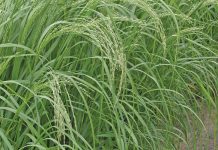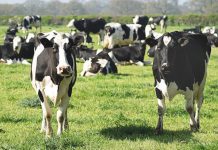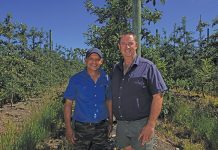After six years of agricultural education and a lifetime of hands-on involvement in vegetable growing, I discovered the merits of the no-till vegetable system only recently. have Hutton soil which was virgin veld in poor condition. The organic content was low and the soil difficult to work with unless the moisture content was just right. T he soil was ripped, limed, and phosphate and potassium were added as indicated by soil analysis. Due to time and economic constraints, avoided asking a farmer to re-chisel, plough and form beds for me. With a somewhat guilty conscience did a quick, light rotavation, added 2:3:4 and LAN and planted. Unintentionally, had gone over to minimum tillage. An immediate improvement noticed that the soil structure improved substantially. Cavity spot (Pythium sulcatum and P. violae), which had been a big problem in my carrots, completely disappeared. reached the next stage of no-till also by accident. had fertilised the beds and could not get the rotavator to start. Eventually lost my temper and decided to plant without incorporating the fertiliser into the soil.
The crop was perfect. Not surprisingly continued with this approach, and noted a steady improvement in organic content and crop performance. When you cultivate you aerate the soil and stimulate the micro-organisms which then tackle the soil humus and deplete the carbon reserves in the soil. With no-till and correct fertilisation, all residue breaks down and is converted into humus at a faster rate than normal, providing a net gain which is reflected in greater water-holding capacity, faster water penetration into the soil and a healthy micro-organism content and balance. No-till with conventional chemical fertilisers will create more humus in the soil than conventional tillage and a regular application of kraal manure does, such is the destructive influence of tillage. A controversial approach to kraal manure E ncouraged by the results, decided to use manure to speed up the process of reconditioning the soil. Kraal manure or broiler chicken litter were used separately, with even better results. One client, although impressed, declared it was wrong not to plough in the kraal manure as one has a only limited period to work it in after application.
However, I was not going to change a system that worked for me. Shortly afterwards, I discovered that an agronomy professor at Kansas University in the US had discovered a net gain of 32% humus when the manure was left on the soil surface, as compared to incorporation. I expected to find a deep layer of humus in the upper soil levels, but discovered that it influenced only the top 15cm to 20cm. Fungi are mostly responsible for infiltrating the soil profile, and earthworms also play a role. The manure I used this year had 39% total moisture. I calculated that I received NPK worth R338/t wet. Farmers in the area were paying R50 to R80/t wet delivered. This is good economics, especially as the value of the organic content was not even considered. Much of no-till seems to defy logic. All my visitors are amazed when I demonstrate how loose my soil is when no implement has touched it for four years. There is a perception that you must loosen the soil to allow water and roots to penetrate adequately, but in fact the opposite is true. Cultivation makes the soil unnecessarily loose, and it also becomes more compact than no-till soil after rain or irrigation. Another client remarked, “It is all well and good, but you can’t take this route with carrots”.
I took a 31cm-long planting trowel and pushed it all the way into the soil between the carrots with my palm. How to grow no-till vegetables Start with a soil analysis and correct any obvious imbalances. Check for hard • layers which may have to be broken with a ripper or chisel plough. It is a good idea to apply kraal manure at this point and then make raised beds. These beds will stay in position forever, so make them nice and straight. Don’t spend time on the paths between beds, which are just tracks for machinery and labour. Leave all fertiliser and manure on the soil surface. Fertilisers which contain nitrogen should be applied just before irrigation. Try to apply manure and fertiliser to the raised bed only, to get the maximum benefit. Where vegetables like cabbages, broccoli, cauliflower and lettuce have been harvested, apply Roundup (glyphosate) and after 10 to 14 days go over the soil with a slasher before planting the next crop. If this step is neglected the remaining stalks may start re-growth. Where fine-seeded crops are planted with a planter, go over the beds with an implement like a rotavator, using low revs and working as shallowly as possible to make an adequate seedbed for good uniform emergence.
Advantages of no-till vegetables There is a substantial saving in fuel, tractors and implements. You have quicker access to the land for planting after rainy periods. There is no leaching of nitrogen after heavy rain in soil where the organic matter has already built up. The organic matter will retain both ammonia and nitrate forms of nitrogen. Non-organic soil will only prevent ammonia from leaching. It makes a huge difference to know that nitrogen is intact after periods of heavy rain. Your crop has far better resistance to pests and diseases. I never spray my beans and there is not one pod with a hole. The taste is far superior. The vegetables are much sweeter and have a better shelf life. This is of great benefit to organic growers. Earthworms increase dramatically and do much of the composting and aeration. They make unavailable plant nutrients available to the crop. There is a balance of soil organisms, including mycorrhiza, which hate cultivation. Having the correct soil organisms reduces fertiliser inputs. Many soil diseases, such as pythium, disappear. The soil pH stabilises at the desired level. Disadvantages of no-till Certain implements are incompatible with the system.
Trailers and tractors must all fit the pathways between the beds. Diseases like blackleg in brassicas may carry over longer in the undecomposed residue on the surface. There are products which can be sprayed on to speed up the breakdown. In certain areas, you can have bigger problems with certain bugs. The higher the organic matter, the more attractive it is for chafer beetle larvae, for example. Ideal for organic and emerging farmers he system is especially useful for resource-poor farmers as there is less capital investment in tractors and implements. Organic growers should also take this route, as it does away with the expense and time-consuming effort of making compost. Costs are down, production up and farming becomes easier. F or some, it may be difficult to implement, but if you understand the principles you can revert to traditional methods occasionally for crops like potatoes, and then return to no-till. he efficient-looking heavy land preparation that we are familiar with may appear grand, organised and scientific, but this is just a veneer covering a rotten system. Most vegetable farmers do far more tillage than is necessary to achieve their purpose. |fw








